tRPC Fast Hands-on
tip
This hands-on use tRPC v9, but now tRPC has released v10. I recommend checking new hands-on for tRPC v10.
Over the past two years, I’ve been trying with different approaches to building type-safe applications for Next.js.
Finally, I discovered tRPC. It allows me to build end-to-end type-safe applications by using the server’s type definitions as the client’s schema, without the need for type generation like graphql-codegen or openapi-codegen. I have been using tRPC for 2 months now and highly recommend it.
However, it takes time to start something new and be able to use it, doesn’t it? tRPC has sample projects that you can start developing right away, but even so, you may put it off, saying, ‘I will try it next time I have time’.
So what if you could experience it in 5 minutes? Wouldn’t you like to try it right now? That’s why I have created a demo that allows you to experience the key concept of tRPC in an instant, so please give it try.
Let’s start!
The demo runs on StackBlitz, so let’s start demo to click bellow button.

You should see a page like this when you click button. This is the StackBlitz loading screen.
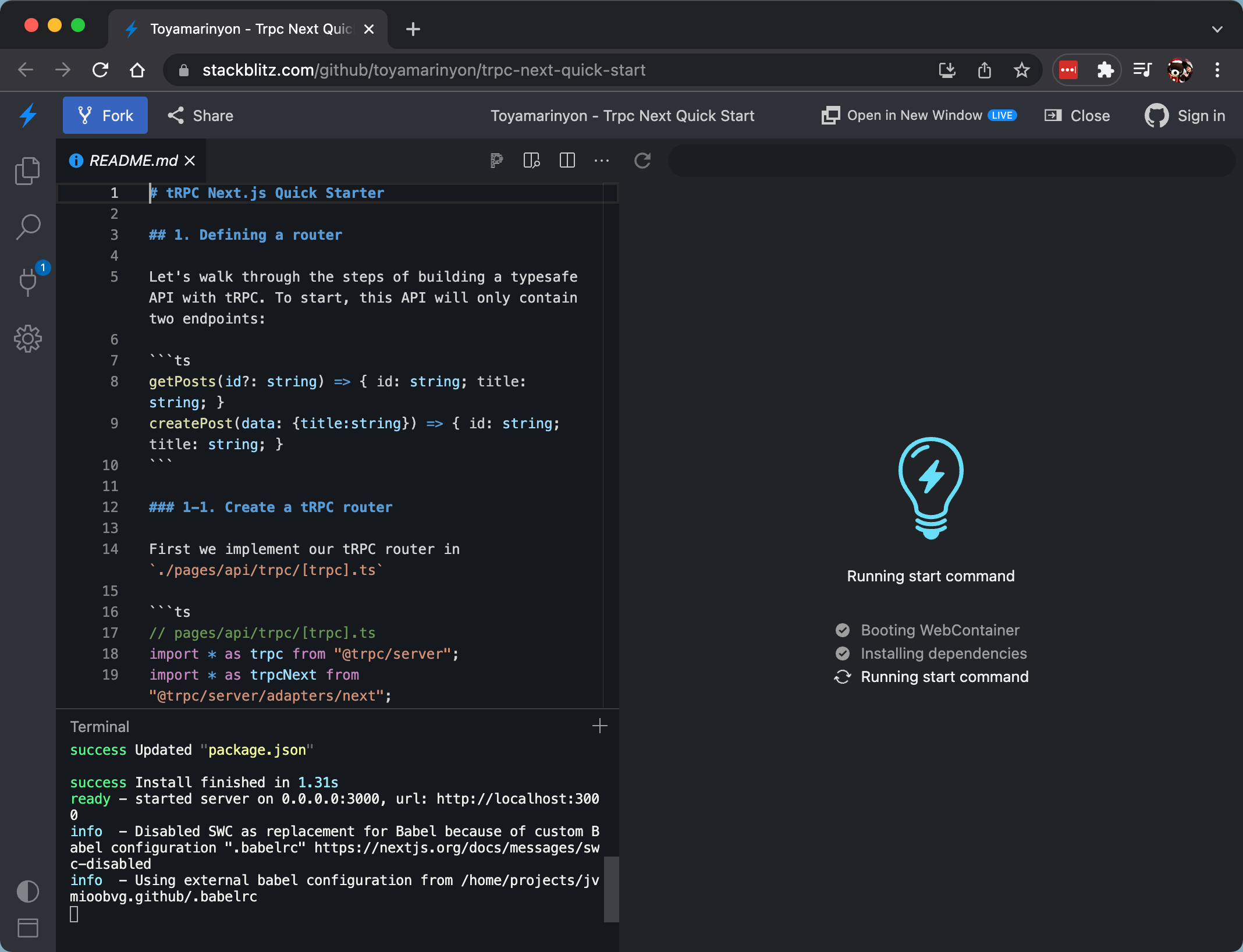
After about 20 seconds, you’ll see the page change like this. This is the starter template page.
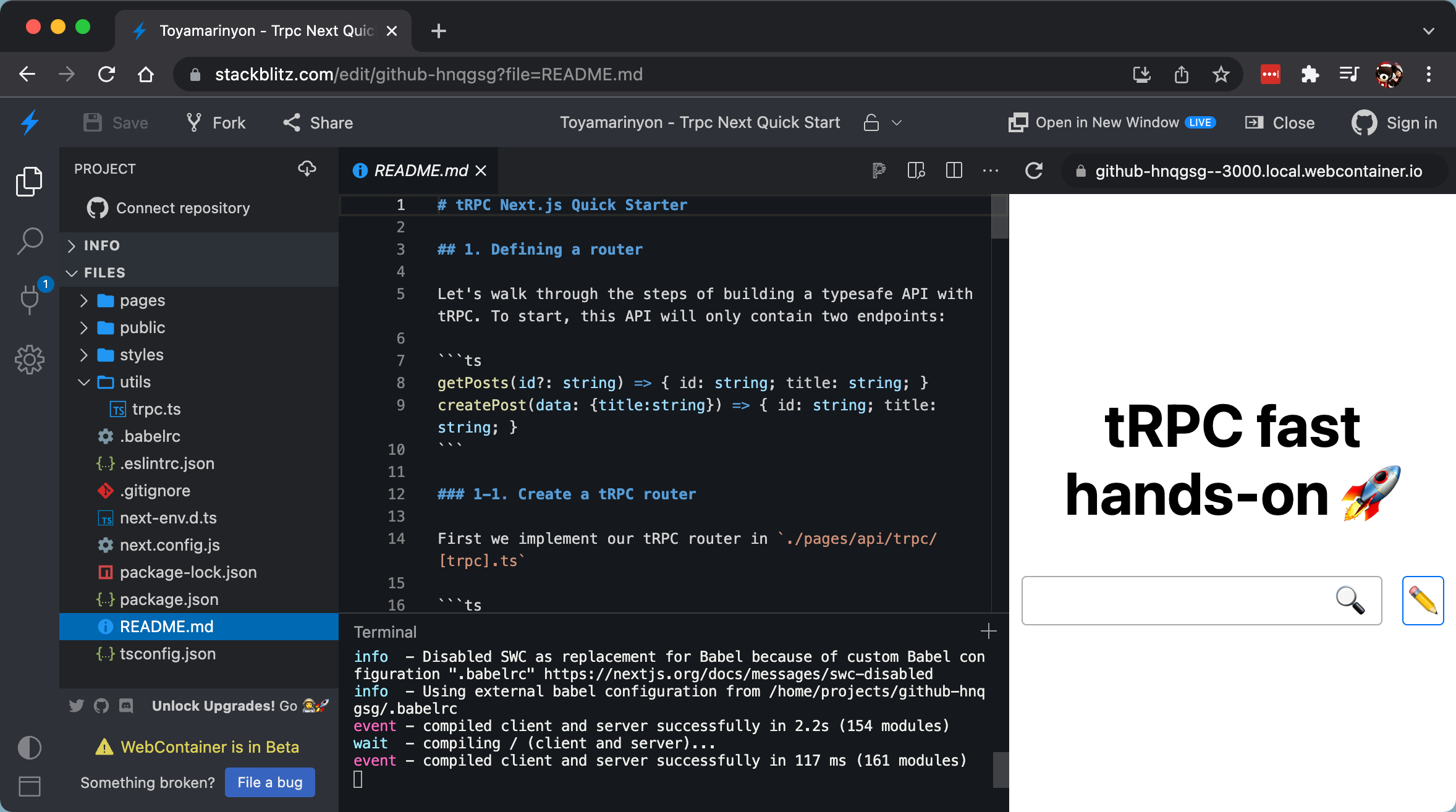
tip
When after about 60 seconds, the page doesn’t change, please reload page to
click browser reload button. 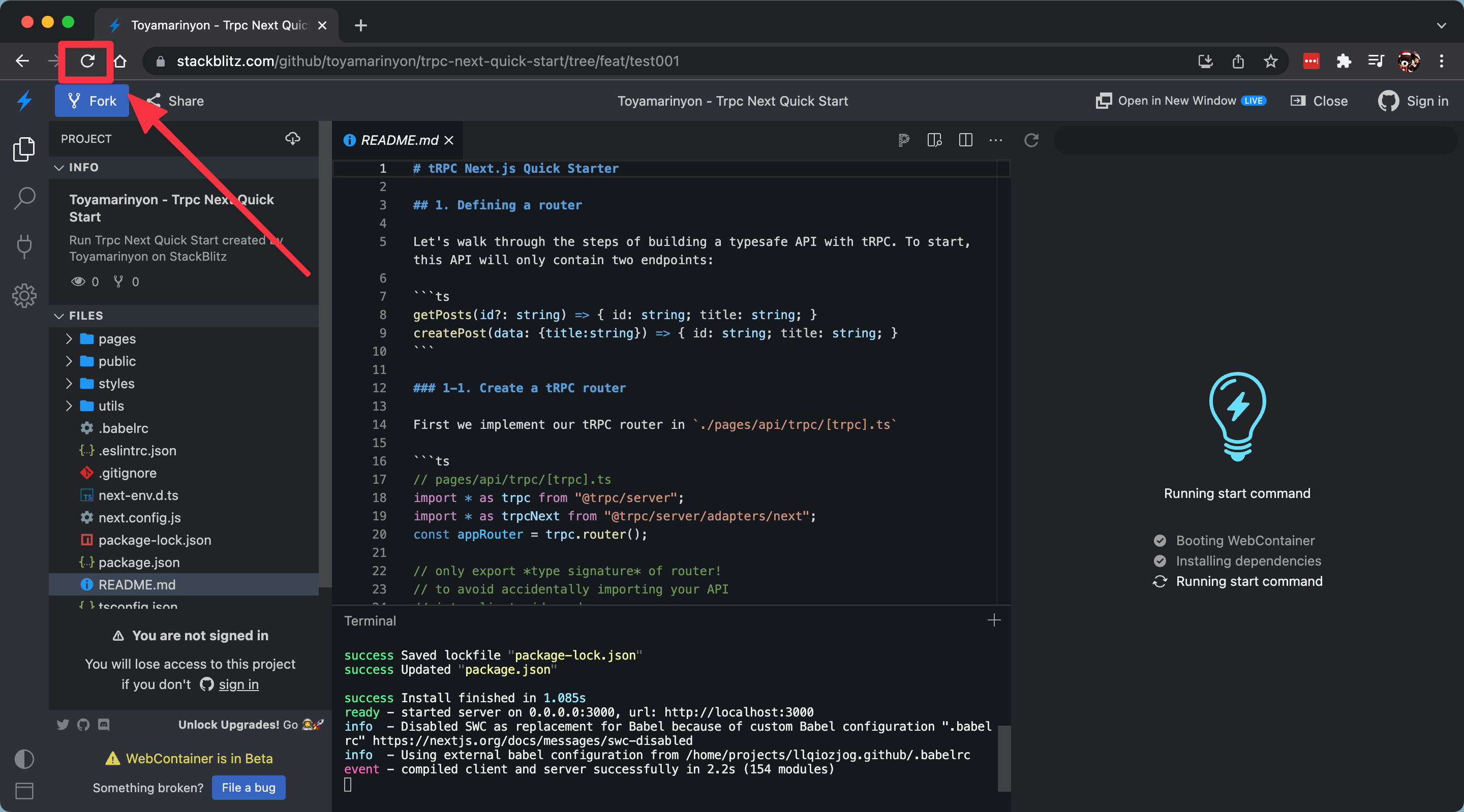
On this page, you will display some posts retrieved by tRPC and also allow you to create posts with building a typesafe API with tRPC.
1. Defining a router
To start, this API will only contain two endpoints:
getPosts(id?: string) => { id: string; title: string; }
createPost(data: {title:string}) => { id: string; title: string; }1-1. Create a tRPC router
First you implement our tRPC router. Create a ./pages/api/trpc/[trpc].ts file with the following contents:
import * as trpc from "@trpc/server";
import * as trpcNext from "@trpc/server/adapters/next";
const appRouter = trpc.router();
// only export *type signature* of router!
// to avoid accidentally importing your API
// into client-side code
export type AppRouter = typeof appRouter;
// export API handler
export default trpcNext.createNextApiHandler({
router: appRouter,
createContext: () => null,
});1-2. Add a query endpoint
Use the .query() method to add a query endpoint to the router. Arguments:
.query(name: string, params: QueryParams)
name: string: The name of this endpointparams.input: Optional. This should be a function that validates/casts the input of this endpoint and either returns a strongly typed value (if valid) or throws an error (if invalid). Alternatively you can pass a Zod, Superstruct or Yup schema. Here we wil useZod.params.resolve: This is the actual implementation of the endpoint. It’s a function with a singlereqargument. The validated input is passed intoreq.inputand the context is inreq.ctx(more about context later!)
To this, add the code to validate input and to respond with dummy data. It looks like this. (Highlight the changed line)
import * as trpc from "@trpc/server";
import * as trpcNext from "@trpc/server/adapters/next";
import { z } from "zod";
// We want to respond with Prisma data retrieved from the database,
// but since StackBlitz cannot use Prisma, we will respond with dummy data.
const posts = [
{
id: 1,
title: "This post come from trpc router!",
},
{
id: 2,
title: `Next, let's create a mutation!`,
},
];
const appRouter = trpc.router().query("posts", {
// validate input with Zod
input: z.object({ filter: z.string() }).nullish(),
async resolve({ input }) {
// if specify input.filter then we will find post matched by input.filter
// else return all posts
if (input?.filter == null || input.filter == "") {
return posts;
}
return posts.filter((post) => post.title.includes(input.filter));
},
});
// only export *type signature* of router!
// to avoid accidentally importing your API
// into client-side code
export type AppRouter = typeof appRouter;
// export API handler
export default trpcNext.createNextApiHandler({
router: appRouter,
createContext: () => null,
});1-3. Add a mutation endpoint
Similarly to GraphQL, tRPC makes a distinction between query and mutation endpoints.
createPost(payload: {title: string}) => {id: string; title: string};Let’s add a createPost mutation endpoint to the router.
import * as trpc from "@trpc/server";
import * as trpcNext from "@trpc/server/adapters/next";
import { z } from "zod";
// We want to respond with Prisma data retrieved from the database,
// but since StackBlitz cannot use Prisma, we will respond with dummy data.
const posts = [
{
id: 1,
title: "This post come from trpc router!",
},
{
id: 2,
title: `Next, let's create a mutation!`,
},
];
const appRouter = trpc
.router()
.query("posts", {
// validate input with Zod
input: z.object({ filter: z.string() }).nullish(),
async resolve({ input }) {
// if specify input.filter then we will find post matched by input.filter
// else return all posts
if (input?.filter == null || input.filter == "") {
return posts;
}
return posts.filter((post) => post.title.includes(input.filter));
},
})
.mutation("createPost", {
// validate input with Zod
input: z.object({
title: z.string().min(5),
}),
async resolve({ input }) {
// We want to create data into Database with Prisma,
// but now we will respond dummy data.
return { id: 9999, title: input.title };
},
});
// only export *type signature* of router!
// to avoid accidentally importing your API
// into client-side code
export type AppRouter = typeof appRouter;
// export API handler
export default trpcNext.createNextApiHandler({
router: appRouter,
createContext: () => null,
});Now, you finished to create router 🎉 Next, you will create a client with Next.js.
2. Create tRPC hooks
Create a set of strongly-typed hooks using your API’s type signature.
Let’s create a ./utils/trpc.ts file with the following contents:
import { createReactQueryHooks } from "@trpc/react";
import type { AppRouter } from "../pages/api/trpc/[trpc]";
export const trpc = createReactQueryHooks<AppRouter>();3. Configure _app.tsx
The createReactQueryHooks function expects certain parameters to be passed via the Context API. To set these parameters, create a custom _app.tsx using the withTRPC higher-order component:
import "../styles/globals.css";
import { AppType } from "next/dist/shared/lib/utils";
import { withTRPC } from "@trpc/next";
import { AppRouter } from "./api/trpc/[trpc]";
const MyApp: AppType = ({ Component, pageProps }) => {
return <Component {...pageProps} />;
};
export default withTRPC<AppRouter>({
config() {
return {
url: "/api/trpc",
};
},
})(MyApp);When you updated the code, you will see an error in the preview window like this. Please reload preview window to click preview window reload button.
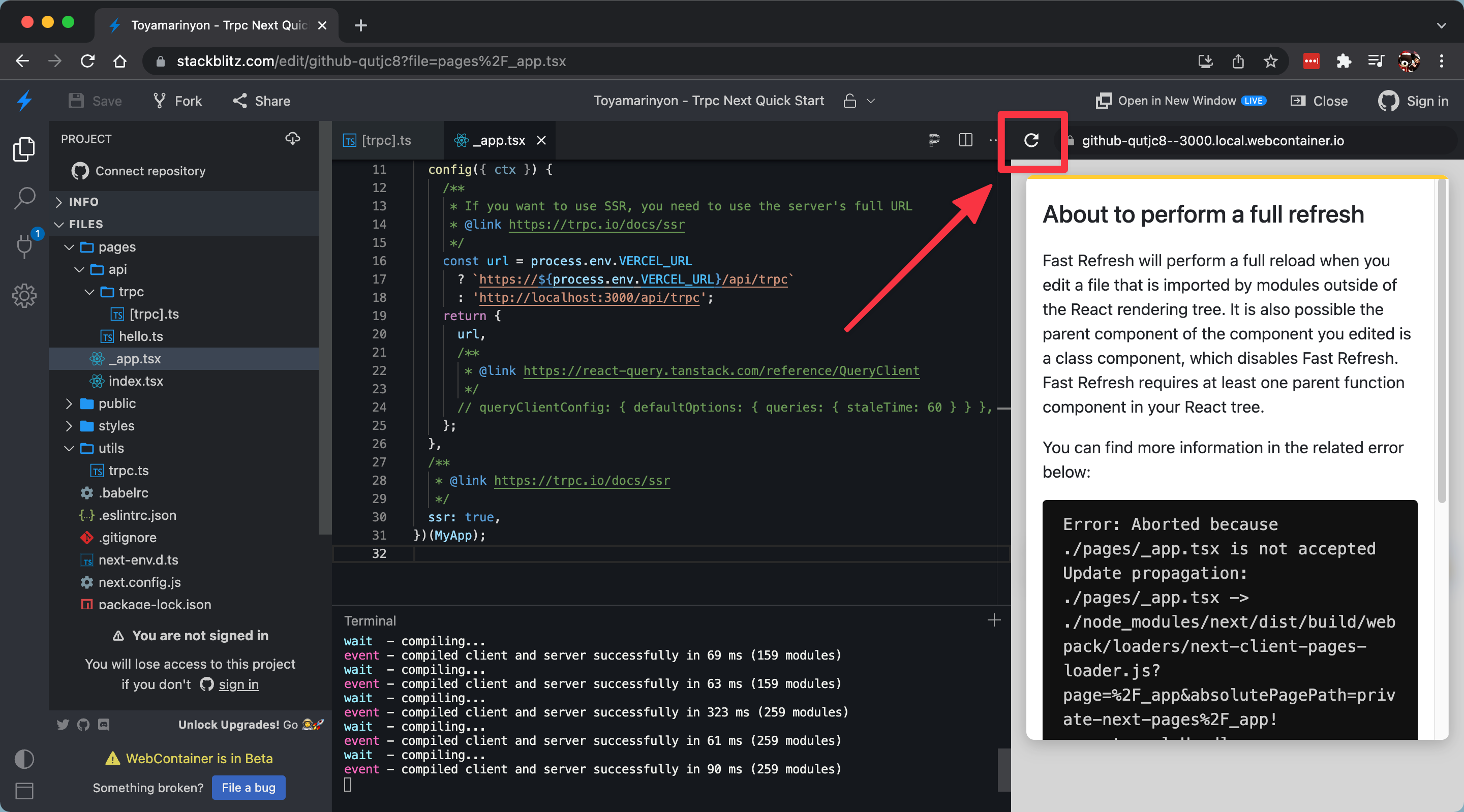
You’re ready! Let’s connect the server created now.
4. Use query
Open src/index.tsx then, add import trpc hook.
import type { NextPage } from "next";
import { FormEvent, useState } from "react";
import styles from "../styles/Home.module.css";
import { trpc } from "../utils/trpc";
:
:
:And, use tRPC query hook like this.
I strongly recommend typing it instead of copy and paste it.
:
:
const [title, setTitle] = useState("");
const [filter, setFilter] = useState("");
const [error, setError] = useState("");
const query = trpc.useQuery(["posts"]); // 👈 Let's type it!
:
:When you type const query = trpc.useQuery(['p, I think you see posts as a candidate, is it working?
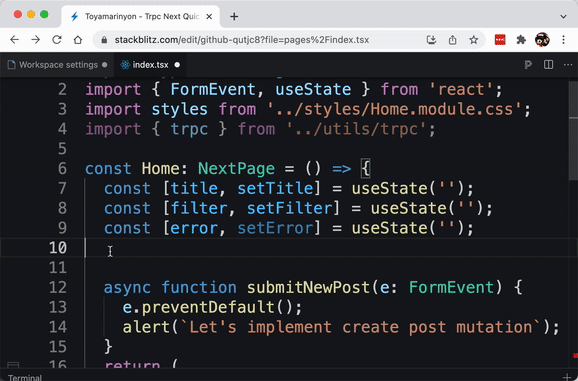
This is possible because tRPC use type information of router that you just created as the scheme for client. You don’t need to generate some file like GraphQL and OpenAPI!
tip
We typed trpc.useQuery(["p to display the candidates. To enter p as the argument of userQuery, you need to remember that the route has “post” in it.
In Visual Studio Code, You can type only trpc.useQuery([" and get a list of query endpoints!
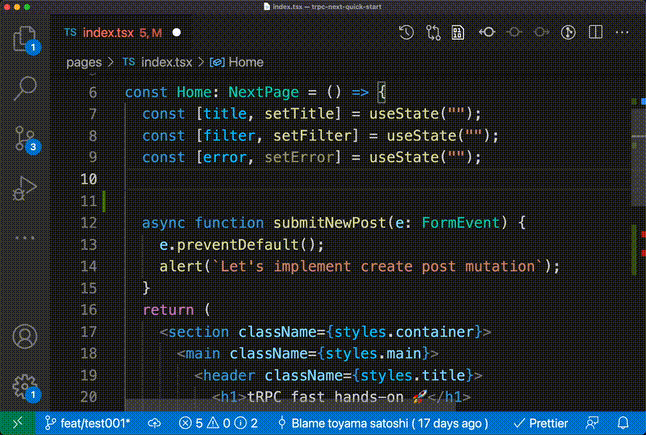
Of corse, I think Stack Blitz also can it, but I don’t know how to set to StackBlitz.
Next, display query result like this.
return (
<section className={styles.container}>
<main className={styles.main}>
<header className={styles.title}>
<h1>tRPC fast hands-on 🚀</h1>
</header>
<section className={styles.controller}>
{/**
* some components
* :
* :
*/}
</section>
<section className={styles.grid}>
{query.data?.map((data, i) => (
<article key={`article-${i}`} className={styles.card}>
<p>{data.title}</p>
</article>
))}
</section>
</main>
</section>query.data is also type safe, so you will type data. inside callback function in map then, appears candidates which id and title.
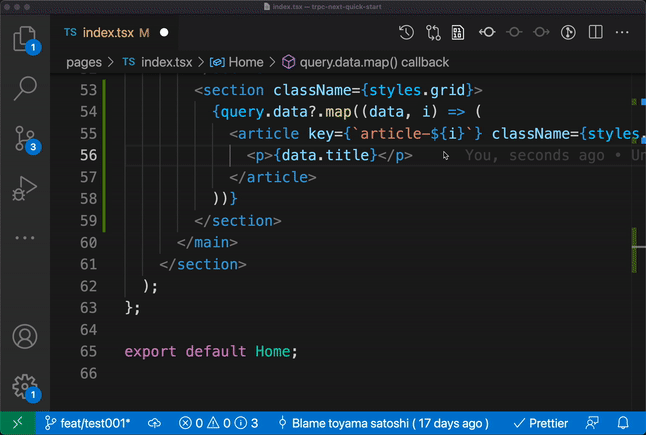
Save the all file, you should see like this.

Congratulation 🎉 Next, you will create a filter with query hook.
6. Use query variable
Actually, there is a post filtering function by input.filter parameter on the server.
query("posts", {
// 👇 input schema
input: z.object({ filter: z.string() }).nullish(),
async resolve({ input }) {
if (input?.filter == null || input.filter == "") {
return posts;
}
// 👇 Filter posts that includes input.filter in the title
return posts.filter((post) => post.title.includes(input.filter));
},
});To use this function in hook, specify it as the first argument tuple.
const query = trpc.useQuery(["posts", { filter: "filtering text" }]);
// ^^^^^^^^^^^^^^^^^^^^^^^^^^^^^There is a text field for filter and We’ve managed it value with field variable, so let’s set it as a query parameter.
:
:
const [title, setTitle] = useState("");
const [filter, setFilter] = useState("");
const [error, setError] = useState("");
const query = trpc.useQuery(["posts", { filter }]);
:
:It will now execute the query every time you type in the text field.
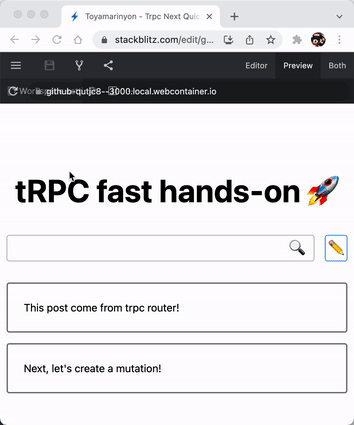
7. Use mutation
Remember, we created createPost mutation at Step 1-3.
createPost(payload: {title: string}) => {id: string; title: string};In client, we can mutate to use useMutation hook like that.
:
:
const [title, setTitle] = useState("");
const [filter, setFilter] = useState("");
const [error, setError] = useState("");
const query = trpc.useQuery(["posts", { filter }]);
const createPost = trpc.useMutation(["createPost"]);
:
:Next, let’s run this hook when the user submits the form.
Since text field value in post form is managed by title state, you will set to mutate param it.
// Text field value in post form is already managed by `title` state
const [title, setTitle] = useState("");And our code has a submit handler like this, so you will mutate there.
async function submitNewPost(e: FormEvent) {
e.preventDefault();
alert(`Let's implement create post mutation`);
}Like this, remove alert function, and add following code.
async function submitNewPost(e: FormEvent) {
e.preventDefault();
// 👇 remove this line ✂️
// alert(`Let's implement create post mutation`);
setError("");
try {
await createPost.mutateAsync({ title });
alert("Successfully created a post!");
} catch (error) {
if (error instanceof TRPCClientError) {
setError(error.message);
}
}
}You will see an error “Cannot find name ‘TRPCClientError’”, so import this.
import { TRPCClientError } from "@trpc/client";
import type { NextPage } from "next";
import { FormEvent, useState } from "react";
import styles from "../styles/Home.module.css";
import { TRPCClientError } from "@trpc/client";Now that you have created the Create post mutation, you can click the ✏️ button, fill in the form, and click the Create button to send the data to the server.

If text that filled in is less than 5 characters long, an error message will be displayed above the form. It’s provided by tRPC input validation with Zod.

You just defined the scheme, you didn’t create any input validation. However, tRPC and Zod make it possible with their schemes.
This hand-on is finished! 👏
Conclusion
I don’t think tRPC will solve all problems like the Swiss Army Knife or Silver Bullet, but I do think it will significantly increase the speed of launching a product.
Especially I consider it has a high affinity for developer who want to build type-safe applications but feel GraphQL and OpenAPI are overreaching.
Some of you who have read this far may have the following questions:
-
“I know the basics, but can I implement a real world application or use case?”
-
“Can I implement authentication and error handling?”
-
“Can I implement localization?”
The answer is yes. I deploy application with tRPC to Vercel and get paid by my clients. This application uses firebase authentication to authenticate user and UI is Japanese.
Once again, I will explain how to authenticate and localize and more. If you are curios it, please follow my twitter account, I’ll let you know.

